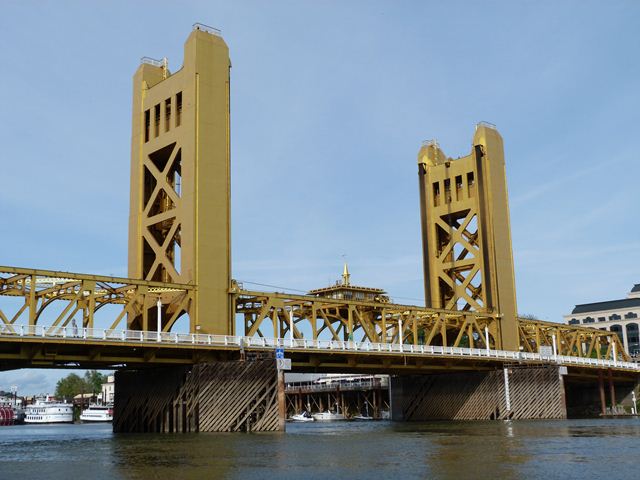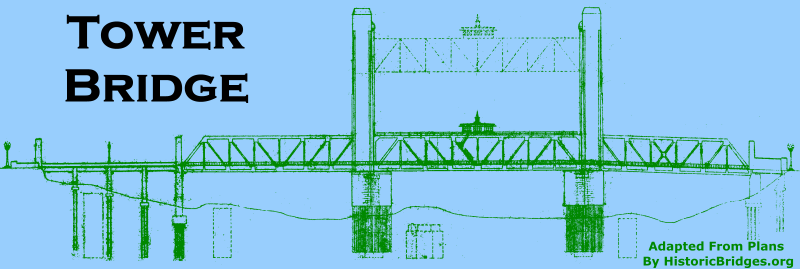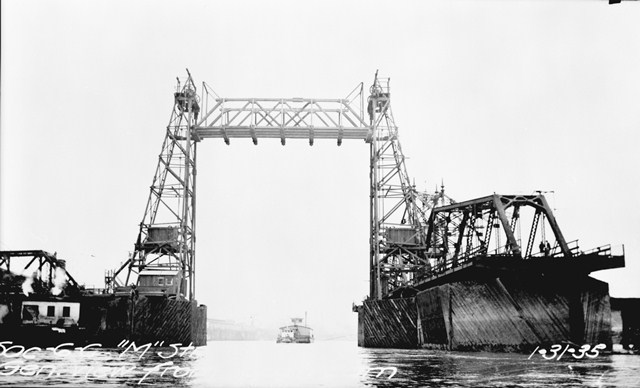We Recommend:
Bach Steel - Experts at historic truss bridge restoration.
BridgeHunter.com Phase 1 is released to the public! - Visit Now
Tower Bridge

Primary Photographer(s): Nathan Holth
Bridge Documented: April 5, 2013
Sacramento and West Sacramento: Sacramento County, California and Yolo County, California: United States
Metal 8 Panel Rivet-Connected Pratt Through Truss, Movable: Vertical Lift (Span Drive) and Approach Spans: Metal 7 Panel Rivet-Connected Pratt Through Truss, Fixed
1934 By Builder/Contractor: Consolidated Steel Company of Los Angeles, California and Engineer/Design: Alfred W. Eichler
Not Available or Not Applicable
209.0 Feet (63.7 Meters)
738.0 Feet (224.9 Meters)
51.8 Feet (15.79 Meters)
1 Main Span(s) and 7 Approach Span(s)
22 0021

View Information About HSR Ratings
Bridge Documentation
View Archived National Bridge Inventory Report - Has Additional Details and Evaluation
View Historic American Engineering Record (HAER) Documentation For This Bridge
HAER Data Pages, PDF
View Historical Articles About This Bridge
View The National Register of Historic Places Nomination Form For This Bridge
This bridge is among the most beautiful and unique vertical lift bridges to be found, and it has more to do with the bridge's appearance rather than its design.
From a design standpoint, the bridge is a span-driven vertical lift bridge with a Pratt through truss lift span, which includes counterweights with counter chains. It should be noted however that the towers themselves do not have legs (posts) that angle outward toward the base, which makes this bridge different from many vertical lift bridges. On either end of the lift span is a Pratt through truss approach span, which is rigidly attached to the towers, a practice that was not uncommon among lift spans that include approach spans. There are also a number of built-up stringer approach spans leading up to the truss spans. However, what makes this bridge unique is that it was designed under the guidance and supervision of an architect, specifically, Alfred Eichler. Eichler came up with the proposed appearance of the bridge which bridge engineers then proceeded to design. The effect of having an architect guiding the design process is strikingly obvious with this bridge's unique and pleasing appearance, that has a strong Streamline Moderne influence, which is a form of Art Deco.
The bracing on the tower posts was completely hidden by decorative solid metal panels. These panels also conceal the counterweight and the counter chains. The faces of the towers have an "x-bracing" that functions similar to many lift bridges, but has been carefully designed so that from the exterior, a flat surface is visible, hiding the flanges and webs of the actual bracing. The top of the tower face has vertical openings. The very tops of the tower are capped off with steel that hides most of the sheaves and matches up with the other covers on the towers. The bridge tender house of the bridge which also doubles as the machinery room is a low-lying structure with a decorative copula on top, positioned on top of the lift span. The lift span and approach truss spans are distinguished by a minimalized use of lattice and v-lacing, likely an attempt to maintain the clean, streamlined appearance found in the towers. The other key distinguishing feature in the trusses is the portal and sway bracing that is a unique arched design. Original ornate riveted lighting is present on the bridge. The approaches to the bridge have two pairs of concrete pillars, with the outermost pair bearing a casting of "1935" at the top.
The on-site contractor for the bridge was George Pollock and Company of Sacramento, California, however a plaque on the bridge points to the builder of the steel structures for the bridge, which was Consolidated Steel Company of Los Angeles, California.
It is interesting to compare this bridge to the Golden Gate Bridge because both bridges have towers with have bracing covered up and/or carefully designed to maintain the Art Deco appearance.
The bridge replaced a through truss swing bridge. A temporary vertical lift bridge was built to serve traffic during construction of the existing vertical lift bridge. The bridge carries a road that dramatically leads right to the State Capitol building, which likely accounts for why a great deal of effort was put toward building an aesthetically pleasing bridge.
The bridge originally carried railroad traffic in the center, with vehicular traffic to the sides, but this was ended in 1963.
The bridge was originally painted silver, but since 1976 has been painted an ochre to give it the appearance of gold. The gold color suits the impressive landmark appearance of the bridge quite well. The concrete pillars on the approaches were originally painted blue, but this wore off long ago and the pillars are not just the color of plain concrete.
![]()
Photo Galleries and Videos: Tower Bridge
Bridge Photo-Documentation
Original / Full Size PhotosA collection of overview and detail photos. This gallery offers photos in the highest available resolution and file size in a touch-friendly popup viewer.
Alternatively, Browse Without Using Viewer
![]()
Bridge Photo-Documentation
Mobile Optimized PhotosA collection of overview and detail photos. This gallery features data-friendly, fast-loading photos in a touch-friendly popup viewer.
Alternatively, Browse Without Using Viewer
![]()
Historical Photos and Drawings
Original / Full Size PhotosHistorical photos showing previous bridge, and construction of current bridge. Also includes architect drawings of bridge. This gallery offers photos in the highest available resolution and file size in a touch-friendly popup viewer.
Alternatively, Browse Without Using Viewer
![]()
Historical Photos and Drawings
Mobile Optimized PhotosHistorical photos showing previous bridge, and construction of current bridge. Also includes architect drawings of bridge. This gallery features data-friendly, fast-loading photos in a touch-friendly popup viewer.
Alternatively, Browse Without Using Viewer
![]()
CarCam: Eastbound Crossing
Full Motion VideoNote: The downloadable high quality version of this video (available on the video page) is well worth the download since it offers excellent 1080 HD detail and is vastly more impressive than the compressed streaming video. Streaming video of the bridge. Also includes a higher quality downloadable video for greater clarity or offline viewing.
![]()
Maps and Links: Tower Bridge
Coordinates (Latitude, Longitude):
Search For Additional Bridge Listings:
Bridgehunter.com: View listed bridges within 0.5 miles (0.8 kilometers) of this bridge.
Bridgehunter.com: View listed bridges within 10 miles (16 kilometers) of this bridge.
Additional Maps:
Google Streetview (If Available)
GeoHack (Additional Links and Coordinates)
Apple Maps (Via DuckDuckGo Search)
Apple Maps (Apple devices only)
Android: Open Location In Your Map or GPS App
Flickr Gallery (Find Nearby Photos)
Wikimedia Commons (Find Nearby Photos)
Directions Via Sygic For Android
Directions Via Sygic For iOS and Android Dolphin Browser
USGS National Map (United States Only)
Historical USGS Topo Maps (United States Only)
Historic Aerials (United States Only)
CalTopo Maps (United States Only)





